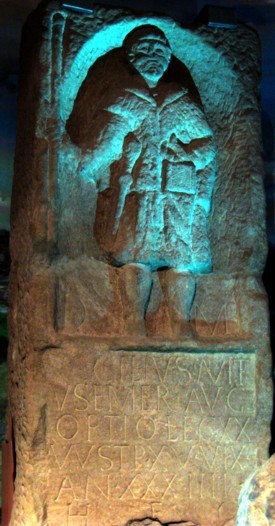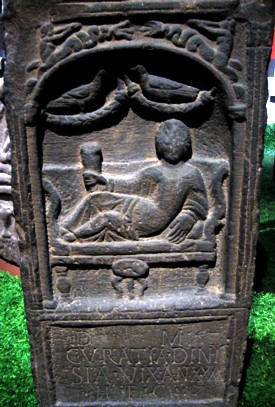Roman Chester


The Romans invaded Britain in AD 43, but it was another 30 years before they reached the north-west of the country. The Roman army arrived in Chester sometime between AD 71 and and 79 and began to build a great fortress on a headland overlooking the River Dee. Their military surveyors carefully laid out a grid of streets centered on a spot that is now known as Chester Cross. The fortress was connected by roads to all parts of The Roman province Britannia. For more than three centuries Chester was one of the most important military bases in the Roman Empire

The principia (headquarters building) was the most important and impressive building in the fortress. Inside it most of the paperwork and day-to-day running of the legion was carried out. A large courtyard was surrounded by offices and stores. Behind the courtyard was a great hall called the basilica. It had aisles and a nave, and would have looked very much like a large church. The legionaries could be called together inside for announcements or presentations. The commander or officer in charge stood on a raised platform (tribunal) at one end of the hall.

Much has been learned about the people of Roman Chester from Roman tombstones discovered at the end of the nineteenth century. Chester's Grosvenor museum houses the largest collection of tombstones from a single Roman site in Britain. The tombstones, which had been reused to repair the city walls over the centuries, tell the stories of men, women and children who came to the fortress of Deva from all over the Roman Empire.
Below is a selection of the many Roman tombstones that are on display at the Grosvenor museum:
 A worn relief of a cavalryman
recovered from the city walls. He appears to be wearing a long shirt of chain mail. In the hand
raised above his head he would have held a spear. His sword belt can just be seen crossing his
chest. A naked barbarian lies beneath the horse's hooves, clutching a six-sided shield. No
inscription has survived other than the letters D.M. for Dis Manibus. Therefore it
is impossible to be sure whether this man belonged to the legion or some other army
unit.
A worn relief of a cavalryman
recovered from the city walls. He appears to be wearing a long shirt of chain mail. In the hand
raised above his head he would have held a spear. His sword belt can just be seen crossing his
chest. A naked barbarian lies beneath the horse's hooves, clutching a six-sided shield. No
inscription has survived other than the letters D.M. for Dis Manibus. Therefore it
is impossible to be sure whether this man belonged to the legion or some other army
unit.
 A
funeral banquet scene showing a bearded man reclining on a couch. He holds up a drinking cup in
his right hand. Above his legs can be seen his sword and helmet complete with plume. Below the
couch are a three-legged table, a boy attendant, and a single detached head. The head may
represent a battle trophy. The man holds his will in the form of a scroll in his left hand.
A
funeral banquet scene showing a bearded man reclining on a couch. He holds up a drinking cup in
his right hand. Above his legs can be seen his sword and helmet complete with plume. Below the
couch are a three-legged table, a boy attendant, and a single detached head. The head may
represent a battle trophy. The man holds his will in the form of a scroll in his left hand.
The inscription reads:
D]:M
AVRELI:LVCI
EQVITIS
H:F:C
Expanded this reads:
Dis Manibus
Aureli Luci equitis heres faciendum curavit.
This means: "To the spirits of the
departed and (the spirit) of
Aurelius Lucius, cavalryman. His heir had this made."
The Romans usually recruited
their cavalry from the less civilised parts of the Empire. Aurelius' appearance, with large
moustache and stiff spiky hair, suggests that he came from a barbarian background. This
impression is increased by the severed head which appears at the bottom of the sculpture. It may
represent a trophy from head-hunting at the end of a battle.
 This fine complete stone shows an
optio. He was a junior officer, second in rank to a centurion, whose duties included some
of the book-keeping for the century. He is dressed in a heavy cloak (sagum), and wears a
legionary's sword at his side. In his right hand he carries a staff of office, while in his left
hand he holds a writing tablet.
This fine complete stone shows an
optio. He was a junior officer, second in rank to a centurion, whose duties included some
of the book-keeping for the century. He is dressed in a heavy cloak (sagum), and wears a
legionary's sword at his side. In his right hand he carries a staff of office, while in his left
hand he holds a writing tablet.
The inscription reads:
D :M
CAECILIVS:AVIT
VS:EMER:AVG
OPTIO:LEG:XX
V:V:STP:XV:VIX
AN:XXXIIII
Expanded this reads:
Dis Manibus Caecilius
Avitus Emerita Augusta optio Legionis XX Valeriae Victricic stipendiorum XV vixit annos
XXXIIII heres faciendum curavit.
This means:
"To the spirits of the departed,
Caecilius Avitus of Emerita Augustus, an optio of the Twentieth Legion Valeria
Victrix, served 15 years and lived for 34 years. His heir had this stone made."
Emerita Augusta is now Merida in south-western Spain.
 One of several
tombstones found in Chester which show the dead person enjoying a banquet in the after-life. A
fat lady lies on a couch, in the normal position used by the Romans when they were eating. In her
hand she holds a drinking cup. A small three-legged table stands in front of the couch. At the
top of the stone are two birds perched on garlands of leaves, and in the corners are two Tritons
(sea monsters - half man, half fish) blowing on seashell trumpets.
One of several
tombstones found in Chester which show the dead person enjoying a banquet in the after-life. A
fat lady lies on a couch, in the normal position used by the Romans when they were eating. In her
hand she holds a drinking cup. A small three-legged table stands in front of the couch. At the
top of the stone are two birds perched on garlands of leaves, and in the corners are two Tritons
(sea monsters - half man, half fish) blowing on seashell trumpets.
The inscription
reads:
D :M
CVRATIA:DINY
SIA:VIX:AN:XXXX
H :F :C
Expanded
this reads:
Dis Manibus Curatia Dinysia vixit annos XXXX heres faciendum
curavit.
This means: "To the spirits of the departed, Curatia Di(?o)nysia. She
lived 40 years. Her heir had this made."
Curatia's second name is Greek in origin.
Like several other people whose tombstones have been found in Chester she must have come from the
eastern part of the Empire, where Greek rather than Latin was the common language.
